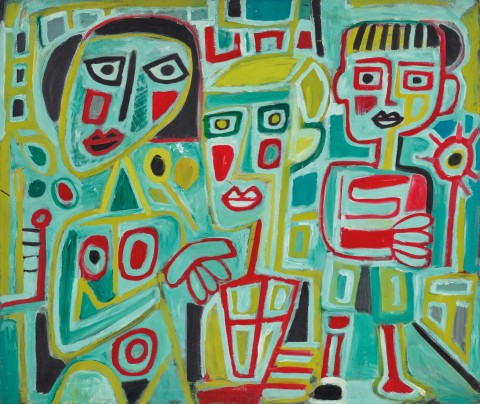FAMILY GROUP, 1952 - 54
TONY TUCKSON
oil on canvas
85.0 x 101.0 cm
Margaret Tuckson, Sydney
Watters Gallery, Sydney (label attached verso)
Private collection, Sydney, acquired from the above on 11 November 1986
Tony Tuckson: Twenty Paintings on Canvas 1947 – 1957, Watters Gallery, Sydney, 1 – 18 October 1986, cat. 17 (as ‘(Family Group, 1952 – 54?)’)
McGrath, S., ‘Tony Tuckson’, Art and Australia, Sydney, vol. 12, no. 2, October – December 1974, p. 159 (illus.)
Thomas, D., Tony Tuckson 1921 – 1973, Art Gallery of New South Wales,
Sydney, 1976, cat. 12, pp. 26, 34 (illus., as (Family Group, 1954?)) [not exhibited]
Thomas, D., Free, R. and Legge, G., Tony Tuckson, Craftsman House, Sydney, 1989, pl. 50, pp. 66 (illus.), 180
While the story of Tony Tuckson’s ‘secret’ life as a painter while he worked at the Art Gallery of New South Wales as Assistant to the Director (1950 – 57) and then, Deputy Director (1957 – 1973) is now something of art world lore, the vitality of the works he produced over the course of his life continue to astound. Prior to his premature death at the age of 52, Tuckson had held only two exhibitions – in 1970 and 1973. As a result, it was not until the memorial exhibition of his work – curated by Daniel Thomas at the Art Gallery of NSW in 1976 – that both the art world and broader viewing public came to comprehend the scope and calibre of his life’s work. Since then, Tuckson has been rightly regarded as one of this country’s most significant artists and foremost abstractionists. Tuckson’s oeuvre charts a journey towards abstraction, and to a level of confidence and freedom that enabled him to produce his masterful abstract works of the early 1970s.
At the time that Family Group, 1952 – 54 was created, Tuckson was absorbing a multitude of artistic influences, heightened in 1953 by first-hand experience of the touring exhibition French Painting Today, which included work by artists ranging from Léger and Picasso to Matisse, Mirò and Soulages. Works from the early to mid-1950s often feature figure groups and scenes from domestic life – subjects that were close to hand as Tuckson painted in the limited time available to him beyond the demands of his role at the Gallery. As Terence Maloon has noted (firmly tongue-in-cheek), the artist’s wife Margaret served as a model for many paintings and drawings:
‘…He half seriously assigned her the role of muse, of archetypal Woman, and she half-jokingly complied. There began a self-conscious and faintly comic series of travesties in which Margaret’s image was tossed between Tuckson’s various influences. For many years she was forced into cousinship with Picasso’s women – case as an angular Dora-Margaret or a curvaceous Margaret-Thérèse Walter. Intermittently she was incarnated as a Matisse odalisque, and during a few frustrated weeks in 1952 she almost became a Modigliani. By the time Tuckson fell under the sway of Dubuffet’s art brut in the mid 1950s, he no longer worked directly from the model – which, I suppose, was just as well for his wife’s morale.’1
The shadow of Picasso certainly looms large in the assured brushstrokes and blocky shapes of Family Group, with the work’s high-keyed palette of yellow, red, blue and black transforming a warm domestic scene into a study of pattern and colour that begins to dissolve the outline of the work’s three figures.
1. Maloon, T., Tony Tuckson: Themes and Variations, Heide Park and Art Gallery, Melbourne, 1989, p. 4
KELLY GELLATLY
